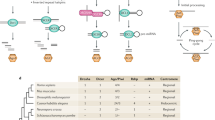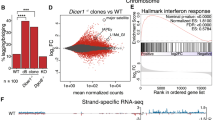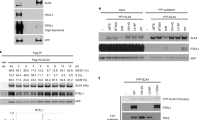Abstract
The yeast Sir protein complex has been implicated in transcriptional silencing and suppression of recombination. The Sir complex creates structured chromosomal domains at telomeres, silent mating-type loci and ribosomal DNA to invoke these functional states. Mechanistic insights into the function of Sir proteins implicate a range of activities in yeast, including repair of DNA double-strand breaks, regulation of the mitotic cell cycle, meiosis and ageing. I speculate that the Sir proteins may be capable of enzymatic modification of chromatin and other substrates, which enables them to carry out a broad range of cellular functions.
This is a preview of subscription content, access via your institution
Access options
Subscribe to this journal
Receive 12 print issues and online access
$209.00 per year
only $17.42 per issue
Buy this article
- Purchase on SpringerLink
- Instant access to full article PDF
Prices may be subject to local taxes which are calculated during checkout




Similar content being viewed by others
References
Craig, I.W. Organization of the human genome. J. Inherit. Metab. Dis. 17, 391–402 (1994).
Murphy, T.D. & Karpen, G.H. Centromeres take flight: α satellite and the quest for the human centromere. Cell 93, 317–320 (1998).
Wakimoto, B.T. Beyond the nucleosome: epigenetic aspects of position-effect variegation in Drosophila. Cell 93, 321– 324 (1998).
Grunstein, M. Yeast heterochromatin: regulation of its assembly and inheritance by histones. Cell 93, 325–328 (1998).
Rine, J. & Herskowitz, I. Four genes responsible for a position effect on expression from HML and HMR in Saccharomyces cerevisiae. Genetics 116, 9– 22 (1987).
Moazed, D., Kistler, A., Axelrod, A., Rine, J. & Johnson, A.D. Silent information regulator protein complexes in S. cerevisiae: a Sir2/Sir4 complex and evidence for a regulatory domain in Sir4 that inhibits its interaction with Sir3. Proc. Natl Acad. Sci. USA 94, 2186–2191 ( 1997).
Hecht, A., Laroche, T., Strahl-Bolsinger, S., Gasser, S. & Grunstein, M. Histone H3 and H4 N-termini interact with Sir3 and Sir4 proteins: a molecular model for the formation of heterochromatin in yeast. Cell 80, 583– 592 (1995).
Braunstein, M., Rose, A., Holmes, S., Allis, C.D. & Broach, J. Transcriptional silencing in yeast is associated with reduced nucleosomal acetylation. Genes Dev. 7, 592–604 (1993).
Loo, S. & Rine, J. Silencers and domains of generalized repression. Science 264, 1768– 1771 (1994).
Bi, X. & Broach, J. DNA in transcriptionally silenced chromatin assumes a distinct topology that is sensitive to cell cycle progression. Mol. Cell. Biol. 17, 7077– 7087 (1997).
Gottschling, D.E. et al. Position effect at S. cerevisiae telomeres: reversible repression of pol 11 transcription. Cell 63, 751–762 (1990).
Moretti, P., Freeman, K., Coodly, L. & Shore, D. Evidence that a complex of Sir proteins interacts with a silencer and telomere-binding protein RAP1. Genes Dev. 8, 2257– 2269 (1994).
Palladino, F. et al. SIR3 and SIR4 proteins are required for the positioning and integrity of yeast telomeres. Cell 75, 543 –555 (1993).
Critchlow, S.E. & Jackson, S.P. DNA end-joining: from yeast to man. Trends Biol. Sci. 23, 394–398 (1998).
Gravel, S., Larrivee, M., Labrecque, P. & Wellinger, R.J. Yeast Ku as a regulator of chromosomal DNA end structure. Science 280, 741–744 ( 1998).
Laroche, T. et al. Mutation of yeast Ku genes disrupts the subnuclear organization of telomeres. Curr. Biol. 8, 653– 656 (1998).
Gottlieb, S. & Esposito, R.E. A new role for a yeast transcriptional silencer gene, SIR2, in regulation of recombination in ribosomal DNA. Cell 56, 771–776 (1989).
Bryk, M. et al. Transcriptional silencing of Ty1 elements in the RDN1 locus of yeast. Genes Dev. 11, 255– 269 (1997).
Smith, J.S. & Boeke, J.D. An unusual form of transcriptional silencing in yeast ribosomal DNA. Genes Dev. 11, 241–254 (1997).
Fritze, C. & Esposito, R. Direct evidence for Sir2 modulation of chromatin structure in yeast rDNA. EMBO J. 16, 6495–6509 (1997).
Brachmann, C.B. et al. The SIR2 gene family, conserved from bacteria to humans, functions in silencing, cell cycle progression, and chromosome stability. Genes Dev. 9, 2888–2902 (1995).
Tsukamoto, Y., Kato, J. & Ikeda, H. Silencing factors participate in DNA repair and recombination in Saccharomyces cerevisiae. Nature 388, 900– 903 (1997).
Astrom, S.U., Okamura, S.M. & Rine, J. Yeast cell-type regulation of DNA repair. Nature 397, 310 (1999).
Mills, K.D., Sinclair, D.A. & Guarente, L. MEC1-dependent redistribution of the Sir3 silencing protein from telomeres to DNA double-strand breaks. Cell 97, 609–620 (1999).
Lee, H.E., Paques, F., Sylvan, J. & Haber, J. Role of yeast SIR genes and mating type in directing DNA double strand breaks to homologous and non-homologous repair paths. Curr. Biol. 9, 767–770 (1999).
Martin, S.G., Laroche, T., Suka, N., Grunstein, M. & Gasser, S.M. Relocalization of telomeric Ku and SIR proteins in response to DNA strand breaks in yeast. Cell 97, 621–633 (1999).
Jeggo, P.A., Carr, A.M. & Lehman, A.R. Splitting the ATM: distinct repair and checkpoint defects in ataxia-telangiectasia. Trends Genet. 14, 312–316 (1998).
Savitsky, K. et al. A single ataxia telangiectasia gene with a product similar to PI-3 kinase. Science 268, 1749– 1784 (1995).
Marcand, S. et al. Silencing of genes at nontelomeric sites in yeast is controlled by sequestration of silencing factors at telomeres by Rap1 protein. Genes Dev. 10, 1297–1309 (1996).
Straight, A.F. et al. Net1, a Sir2-associated nucleolar protein required for rDNA silencing and nucleolar integrity. Cell 97, 245–256 (1999).
Schwab, M., Lutum, A.S. & Seufert, W. Yeast Hct1 is a regulator of Clb2 cyclin proteolysis. Cell 90, 683–693 (1997).
Visintin, R., Prinz, S. & Amon, A. CDC20 and CDH1: a family of substrate-specific activators of APC-dependent proteolysis. Science 278, 460– 463 (1997).
Visintin, R., Hwang, E. & Amon, A. Cfi1 prevents premature exit from mitosis by anchoring Cdc14 phosphatase in the nucleolus. Nature 398, 818– 823 (1999).
Shou, W. et al. Exit from mitosis is triggered by tem1-dependent release of the protein phosphatase Cdc14 from Nucleolar RENT Complex. Cell 97, 233–244 (1999).
Weber, J.D. et al. Nucleolar Arf sequesters Mdm2 and activates p53. Nature Cell Biol. 1, 20–26 (1999).
Zhang, Y. & Xiong, Y. Mutations in human ARF exon 2 disrupt its nucleolar localization and impair its ability to block nuclear export of MDM2 and p53. Mol. Cell 3, 579– 591 (1999).
San-Segundo, P.A. & Roeder, G.S. Pch2 links chromatin silencing to meiotic checkpoint control. Cell 97, 313–324 (1999).
Sym, M., Engebrecht, J. & Roeder, G.S. ZIP1 is a synaptonenmal complex protein required for meiotic chromosome synapsis. Cell 72, 365 –378 (1993).
Mortimer, R.K. & Johnston, J.R. Life span of individual yeast cells. Nature 183, 1751 –1752 (1959).
Sinclair, D.A., Mills, K. & Guarente, L. Molecular mechanisms of yeast aging. Trends Biol. Sci. 23, 131–134 ( 1998).
Kaeberlein, M., McVey, M. & Guarente, L. The Sir2/3/4 complex and Sir2 alone promote longevity in S. cerevisiae by two different mechanisms. Genes Dev. 13, 2570–2580 (1999).
Sinclair, D.A. & Guarente, L. Extrachromosomal rDNA circles—a cause of aging in yeast. Cell 91, 1033–1042 (1997).
Park, P.U., Defossez, P.A. & Guarente, L. Effects of mutations in DNA repair genes on formation of ribosomal DNA circles and life span in Saccharomyces cerevisiae. Mol. Cell. Biol. 19, 3848– 3856 (1999).
Defossez, P.A. et al. Elimination of replication block protein Fob1 extends the life span of yeast mother cells. Mol. Cell 3, 447–455 (1999).
Rothstein, R. & Gangloff, S. The shuffling of a mortal coil. Nature Genet. 22, 4–6 (1999).
Kobayashi, T. & Horiuchi, T. A yeast gene product, Fob1 protein, required for both replication fork blocking and recombination hotspot activities. Genes Cells 1, 465–474 (1996).
Brewer, B.J. & Fangman, W.L. A replication fork barrier at the 3′ end of yeast ribosomal RNA genes. Cell 55, 637–643 (1988).
Frye, R.A. Characterization of five human cDNAs with homology to the yeast SIR2 gene: Sir2-like proteins (Sirtuins) metabolize NAD and may have protein ADP-ribosyltransferase activity. Biochem. Biophy. Res. Commun. 260, 273–279 (1999).
C. elegans sequencing consortium. Genome sequence of the nematode C. elegans: a platform for investigating biology. Science 282, 2012–2018 (1998).
Sherman, J.M. et al. The conserved core of a human SIR2 homolog functions in yeast silencing. Mol. Biol. Cell 10, 3045– 3059 (1999).
Perez-Martin, J., Uria, J.A. & Johnson, A.D. Phenotypic switching in Candida Albicans is controlled by a SIR2 gene. EMBO J. 18, 2580–2592 (1999).
Tsang, A.W. & Escalante-Semerena, J.C. CobB, a new member of the SIR2 family of eucaryotic regulatory proteins, is required for the lack of nicotinate mononucleotide: 5, 6-dimethylbenzimidazole phophoribosyltransferase activity in cobT mutants during cobalamin biosynthesis in Salmonella typhimurium LT2. J. Bacteriol. 178, 7016–7019 (1996).
Acknowledgements
I thank colleagues in the field for stimulating discussions. Work from my laboratory was supported by grants from the NIH, the Seaver Institute, The Ellison Medical Foundation, and The Howard and Linda Stern Fund.
Author information
Authors and Affiliations
Rights and permissions
About this article
Cite this article
Guarente, L. Diverse and dynamic functions of the Sir silencing complex. Nat Genet 23, 281–285 (1999). https://doi.org/10.1038/15458
Received:
Accepted:
Issue Date:
DOI: https://doi.org/10.1038/15458
This article is cited by
-
Sirtuins and the circadian clock interplay in cardioprotection: focus on sirtuin 1
Cellular and Molecular Life Sciences (2021)
-
Induction of sirtuin-1 signaling by resveratrol induces human chondrosarcoma cell apoptosis and exhibits antitumor activity
Scientific Reports (2017)
-
Relationships between rDNA, Nop1 and Sir complex in biotechnologically relevant distillery yeasts
Archives of Microbiology (2016)
-
Emerging roles of nucleolar and ribosomal proteins in cancer, development, and aging
Cellular and Molecular Life Sciences (2015)
-
Resveratrol relieves hydrogen peroxide-induced premature senescence associated with SIRT1 in human mesenchymal stem cells
Molecular & Cellular Toxicology (2014)



